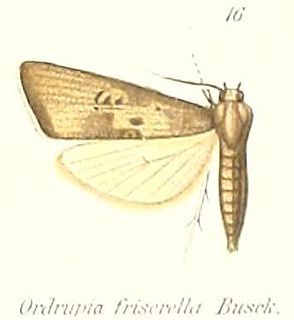Related Research Articles

Copromorphidae, the "tropical fruitworm moths" is a family of insects in the lepidopteran order. These moths have broad, rounded forewings, and well-camouflaged scale patterns. Unlike Carposinidae the mouthparts include "labial palps" with the second rather than third segment the longest. With other unusual structural characteristics of the caterpillar and adult, it could represent the sister lineage of all other extant members of this superfamily. The genus Sisyroxena from Madagascar is also notable for its unusual venation and wing scale sockets.

Arrhythmica is a monotypic moth genus in the subfamily Arctiinae. Its single species, Arrhythmica semifusca, is found in Australia. Both the genus and species were first described by Turner in 1940.
Atelophleps is a monotypic moth genus in the subfamily Arctiinae. Its single species, Atelophleps tridesma, is found in Australia. Both the genus and the species were first described by Turner in 1940.
Ateucheta is a monotypic moth genus in the subfamily Arctiinae erected by Alfred Jefferis Turner in 1940. Its single species, Ateucheta zatesima, was first described by George Hampson in 1914. It is found in Australia.
Cheliosea is a genus of tiger moths in the family Erebidae described by Watson in 1980. The moths in the genus are found in Australia.

Hypatima is a genus of the twirler moth family (Gelechiidae). Among these, it belongs to a distinct lineage, which is variously treated as tribe Chelariini in subfamilies Dichomeridinae, Gelechiinae, or even Pexicopiinae, and historically was considered a subfamily in its own right, Chelariinae. Of this lineage, Hypatima – under its junior synonym Chelaria – is the type genus. This genus has numerous species, but its exact limits are not quite clear. This genus occurs mainly in the Southern Hemisphere, though one of the better-known species is the only member of this genus native to Europe, the lobster-clawed moth.

Halone is a genus of moths in the subfamily Arctiinae from southern Asia and Australia. The genus was erected by Francis Walker in 1854.
Heterotropa is a monotypic moth genus in the subfamily Arctiinae. Its single species, Heterotropa fastosa, is found in Australia's Northern Territory and Queensland. Both the genus and species were first described by Turner in 1940.
Hobapromea is a monotypic moth genus in the subfamily Arctiinae described by Watson in 1980. Its single species, Hobapromea cleta, was first described by Turner in 1940. It is found in Queensland, Australia.
Phenacomorpha is a monotypic moth genus in the subfamily Arctiinae described by Turner in 1940. Its single species, Phenacomorpha bisecta, was first described by Thomas Pennington Lucas in 1891. It is found in Australia.
Pseudophanes is a genus of moths in the subfamily Arctiinae. Its single species, Pseudophanes melanoptera, is found in Australia. Both the genus and species were first described by Turner in 1940.
Aboetheta is a monotypic moth genus of the Spilomelinae subfamily of the Crambidae described by Alfred Jefferis Turner in 1914. The sole species in the genus, Aboetheta pteridonoma, was described by the same author in the same year, and is found in Australia.

The Depressariinae – sometimes spelled "Depressiinae" in error – are a subfamily of moths in the superfamily Gelechioidea. Like their relatives therein, their exact relationships are not yet very well resolved. It has been considered part of family Elachistidae sensu lato or included in an expanded Oecophoridae. In modern classifications they are treated as the distinct gelechioid family Depressariidae.

Tinea is a genus of the fungus moth family, Tineidae. Therein, it belongs to the subfamily Tineinae. As evident by its name, it is the type genus of its subfamily and family. Established as one of the first subgroups of "Phalaena", it used to contain many species of Tineidae that are nowadays placed in other genera, as well as a few moths nowadays placed elsewhere.

Lyonetia is a genus of moths in the family Lyonetiidae.

Xyloryctidae is a family of moths contained within the superfamily Gelechioidea described by Edward Meyrick in 1890. Most genera are found in the Indo-Australian region. While many of these moths are tiny, some members of the family grow to a wingspan of up to 66 mm, making them giants among the micromoths.
Ameleta is a monotypic moth genus in the subfamily Arctiinae. Its only species, Ameleta panochra, is found in Queensland, Australia. Both the genus and species were first described by Turner in 1940. The habitat consists of wet tropical areas.

Procometis is a genus of moths in the family Autostichidae.
Heosphora is a genus of moths in the family Pyralidae. The genus was first described by Edward Meyrick in 1882. The type species is Anerastia psamathella Meyrick, 1879, designated as such by George Hampson in 1901. All Heosphora species are found in Australia.
References
- ↑ Savela, Markku (June 25, 2015). "Oreopola Turner, 1940". Lepidoptera and Some Other Life Forms. Retrieved October 24, 2019.
- ↑ Australian Faunal Directory
- Pitkin, Brian & Jenkins, Paul. "Search results Family: Arctiidae". Butterflies and Moths of the World. Natural History Museum, London.
| This Lithosiini-related article is a stub. You can help Wikipedia by expanding it. |